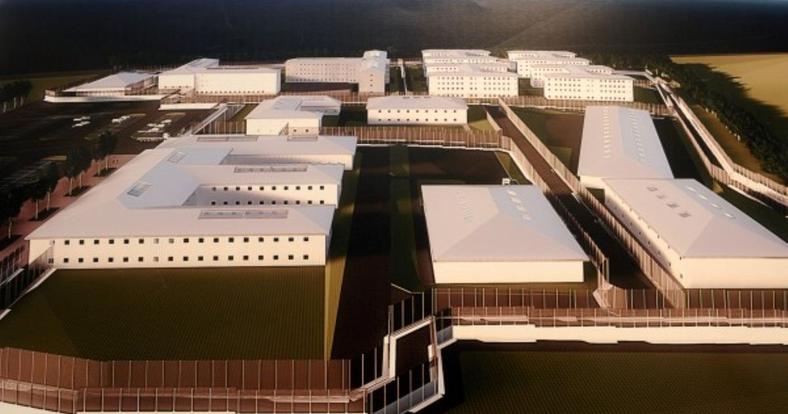Founded 1980
Chair:
Secretary:
Treasurer:
Graham Smith
Jan Thompson
Graham Mumby-Croft
John Berry
Issue No. 77 Autumn 2017
GLEN PARVA
HM Borstal Glen Parva was built on the site of the old Wigston Army Barracks. Their creation took place as part of the Cardwell Reforms, which encouraged the localisation of British military forces. The barracks became the depot for the two battalions of the 17th Leicestershire Regiment of Foot and the 45th Nottinghamshire Regiment of Foot. Following the Childers Reforms of 1881 the barracks became the depot of the Leicestershire Regiment. Tens of thousands of recruits and conscripts were trained there for deployment during the First World War. The barracks went on to become the regional centre for infantry training as the Forester Brigade Depot in 1960. They were closed in the late 1960s and most of the buildings were sold off.
In the 1970s a decision was made to build a Borstal on the site and prisoners from Ashwell open prison (now closed) were deployed along with Trades officers and contractors to build the establishment. However a unit of the Royal Army Pay Corps occupied a building at the front of the site until 1997.
Peter Timms was appointed as the first Governor and developed a progressive regime for borstal boys. Glen Parva also had a large hospital complex built on the site, which contained an operating theatre in the basement (never commissioned).
In 1980 I was posted from HM Borstal Feltham to Glen Parva because a decision had been taken to convert the establishment into a psychiatrically supported borstal along the lines of Feltham. At the time I think there were also plans to do the same to HM Borstal Hindley, although to my knowledge that decision was never implemented. The idea was that borstal boys with complex mental/physical health/ personality problems would not have to be sent far away from home (to Feltham) to receive treatment and that local(ish) Borstals would be developed to meet their needs. The hospital at Glen Parva was also going to be able to offer ‘in-house’ operations for borstal boys, an interesting if unworkable concept but in line with the ‘in-house’ operating theatres at some of the adult prisons.
When I arrived at Glen Parva the site was being operated on a non-traditional management model. The Borstal was run by Ian Boon, a Governor 3, reporting to the ARD Young Offenders, one Cowper-Johnson who was a real character for those who do not know of him; the whole site was under the control of a Governor 2 Derek Shaw (who died recently). As you can imagine this was an uncomfortable management model, which was latterly compounded when the Remand centre was opened and another independent Governor 3 arrived. Eventually this model was changed and the whole site put under a Governor 1 with the two G3s running the North and South ends but under the control of the Governor 1(Ted Williams).
Glen Parva had a history of community work with up to 20 boys a day going into the community to work on a variety of projects from old people’s homes to a children’s home for severely disturbed children. We also expanded the use of Community Service Volunteers (CSV) work with the borstal boys and before I
left we were sending out around 100 boys a year on 1-month projects and had just started the first 3month project. We also ran a significant number of camps, both those arranged by the PE staff and others via the Acorn Trust and a range of other voluntary organisations.
We had our failures – very few and no spectacular ones!! The best ones include the boy, who went on a PE canoeing camp in winter, spent all week with the group then absconded on the last evening. When asked why he said, “Well I did not want to spoil it for the rest of the lads”. Then there was the borstal boy who went out every day on his bike to a children’s home. Returning one evening the staff escorted him and his bike to the unit. The officer ‘dinged’ the bell just to see if it worked and nothing happened. Upon opening the bell he found it stuffed with cannabis – “Fair cop Gov” said the lad.
Assistant Governors in those days did the allocation of boys to the various units. When I went down for the first time to do the allocation, an officer handed me a small wooden mirror type of frame. ‘What is
this for?’ I asked, awaiting the usual response!! It’s for lads with small heads he said. Asking for a bit more explanation he gave me the history of the cell windows at Glen Parva which, if you had a small head you could get out of and so some cells had ‘stops’ in the window frame so that the window could not open fully – hence the frame for establishing who had a small head!! Apparently one of the Principal Officers was going home when a boy leaned out of the window and waved goodnight to him. He had got to the gate before realising what he had seen. Still, it stopped the shopping trips by borstal boys who were going to the local shops to buy a range of items for their friends. We also had the only canteen, which regularly took in more money than we paid out in wages. As those of you who remember Borstal will know, many
of the lads were paid in cash and so money flowed into the borstal on a regular basis to be spent in the canteen amongst other things.
In 1983, the Borstal system ended and the Young Offender sentence was introduced which also put the borstal staff into uniform. Did it change the young offender system? – Yes, it did. Gradually increasing security concerns started to impact on the freedoms Borstal governors had. We forgot that young men make mistakes as they grow up and whilst we did not suffer the same security concerns as exist today, it did have some impact on our thinking and ability to maximise the flexible use of young offender sentences. In 1984 I moved to Gartree and I was told that it would be a very different experience from working at Feltham and Glen Parva. Whilst that was true, one of the first prisoners I met had been a lad I knew at Feltham. The techniques you learned in dealing with difficult borstal boys were equally useful in dealing with difficult prisoners.
By the time you read this, Glen Parva will be closed and probably demolished. The new prison will be a Cat C adult establishment with up to 1800+ prisoners. The new design will take note of the concerns of the local residents and so the cells will all face inwards to minimise noise. The latest plan of the building is attached but as with all things it may change as we move forward to starting the build. Windows will be toughened glass without bars (at the moment) and a range of educational and vocational classes and courses are planned. The biggest question is will it be private or publically operated?
At least it won’t suffer from the problems of the old North end at Glen Parva which had trouble with the drains etc. I did however find out what caused that, when a prisoner at HMP Stocken who had been working on Glen Parva when he was serving a sentence at HMP Ashwell, told me he managed to put concrete down some of the drains. We also had the only prison hospital, which had inter-floor communication.
Half of the hospital was built on a concrete raft, the other half on piles so it split down the middle. When I was there the crack was noticeable, later on it opened up and notes could be passed between the floors.
I enjoyed my time both at Feltham and Glen Parva and sadly, both have now been demolished and rebuilt.
John Berry OBE JP
Below the new design for Glen Parva



